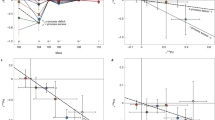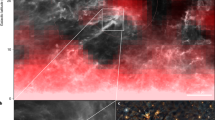Abstract
Primitive meteorites contain isotopes that are the decay products of short-lived nuclides in the early Solar System1,2. The relative abundances of these isotopes provide a means to determine timescales for the formation and accretion of primitive Solar System objects, the abundances of the parent nuclides being fixed when these objects solidified. The abundances can also be used to investigate the source of the nuclides (such as 41Ca, 26Al, 60Fe, 53Mn and 107Pd), although this is an area of controversy. The nuclides could have originated from a single stellar object2,3,4,5,6, such as a nearby red-giant or a supernova. But observations of enhanced ion fluxes in a molecular cloud7 have led to other models8,9,10 in which these nuclides are formed by energetic particle irradiation of gas and dust in the protosolar molecular cloud; alternatively, irradiation by energetic particles from the active early Sun may have occurred within the solar nebula itself11,12,13,14,15,16,17,18. Here we show that there is a correlation between the initial abundances of 41Ca and 26Al in samples of primitive meteorite (as inferred from their respective decay products, 41K and 26Mg), implying a common origin for the short-lived nuclides. We can therefore rule out the mechanisms based onenergetic particle irradiation, as they cannot produce simultaneously the inferred initial abundances of both nuclides. If, as our results suggest, a single stellar source is responsible for generating these nuclides, we can constrain to less than one million years the timescale for the collapse of the protosolar cloud to form the Sun.
This is a preview of subscription content, access via your institution
Access options
Subscribe to this journal
Receive 51 print issues and online access
$199.00 per year
only $3.90 per issue
Buy this article
- Purchase on Springer Link
- Instant access to full article PDF
Prices may be subject to local taxes which are calculated during checkout

Similar content being viewed by others
References
Waserburg, G. J. in Protostars and Planets II (eds Black, D. C. & Matthews, M. S.) 703–737 (Univ. Arizona Press, Tucson, 1985).
Cameron, A. G. W. in Protostars and Planets III (eds Levy, E. H. et al.) 47–73 (Univ. Arizona Press, Tucson, 1993).
Wasserburg, G. J., Busso, M., Gallino, R. & Raiteri, C. M. Asymptotic Giant Branch Stars as a source of short-lived radioactive nuclei in the solar nebula. Astrophys. J. 424, 412–428 (1994).
Wasserburg, G. J., Gallino, R., Busso, M., Goswami, J. N. & Raiteri, C. M. Injection of freshly synthesized 41Ca in the early solar nebula by an asymptotic giant branch star. Astrophys. J. Lett. 440, L101–L104 (1995).
Cameron, A. G. W., Höflich, P., Myers, P. C. & Clayton, D. D. Massive supernova, Orion gamma rays and the formation of the solar system. Astrophys. J. Lett. 447, L53–L57 (1995).
Arnould, M., Paulus, G. & Meynet, G. Short-lived radionuclide production by non-exploding Wolf–Rayet stars. Astron. Astrophys 321, 452–465 (1997).
Bloemen, H. et al. COMPTEL observations of the Orion complex: Evidence for cosmic-ray induced gamma ray lines. Astron. Astrophys. 281, L5–L8 (1994).
Clayton, D. D. Production of 26Al and other extinct radionuclides by low-energy heavy cosmic rays in molecular clouds. Nature 368, 222–224 (1994).
Clayton, D. D. & Jin, L. Gamma rays, cosmic rays, and extinct radioactivity in molecular cloud. Astrophys. J. 451, 681–699 (1995).
Ramaty, R., Kozlovsky, B. & Lingenfelter, R. E. Light isotopes, extinct radioisotopes and gamma ray lines from low energy cosmic ray interactions. Astrophys. J. 456, 525–540 (1996).
Heymann, D. & Dziczkaniec, M. Early irradiation of matter in the solar system: Magnesium (proton, neutron) scheme. Science 191, 79–81 (1976).
Clayton, D. D., Dwek, E. & Woosley, S. E. Isotopic anomalies and proton irradiation in the early solar system. Astrophys. J. 214, 300–315 (1977).
Heymann, D., Dziczkaniec, M., Walker, A., Huss, G. & Morgan, J. A. Effects of proton irradiation on a gas phase in which condensation take place. I. negative 26Mg anomalies and 26Al. Astrophys. J. 225, 1030–1044 (1978).
Lee, T. Alocal proton irradiation model for isotopic anomalies in the solar system. Astrophys. J. 219, 217–226 (1978).
Wasserburg, G. J. & Arnould, M. in Lecture Notes in Physics 287, 4th Workshop on Nuclear Astrophysics (eds Hillebrandt, W. et al.) 262–276 (Springer, Heidelberg, 1987).
Clayton, D. D. & Jin, L. Anew interpretation of 26Al in meteoritic inclusions. Astrophys. J. Lett. 451, L87–L91 (1995).
Shu, F. H., Shang, H. & Lee, T. Toward an astrophysical theory of chondrites. Science 271, 1545–1552 (1996).
Shu, F. H., Shang, H., Glassgold, E. & Lee, T. X-rays and fluctuating X-wind from protostars. Science 277, 1475–1479 (1997).
Srinivasan, G., Sahijpal, S., Ulyanov, A. A. & Goswami, J. N. Ion microprobe studies of Efremovka CAIs: II. Potassium isotope composition and 41Ca in the early solar system. Geochim. Cosmochim. Acta 60, 1823–1835 (1996).
Goswami, J. N., Srinivasan, G. & Ulyanov, A. A. Ion microprobe studies of Efremovka CAIs: I. Magnesium isotope composition. Geochim. Cosmochim. Acta 58, 431–447 (1994).
Fahey, A. J., Goswami, J. N., McKeegan, K. D. & Zinner, E. K. 26Al, 244Pu, 50Ti, REE, and trace element abundances in hibonite grains from CM and CV meteorites. Geochim. Cosmochim. Acta 51, 329–350 (1987).
Cantanzaro, E. J., Murphy, T. J., Garner, E. L. & Shields, W. R. Absolute isotopic abundance ratios and atomic weights of magnesium. J. Res. NBS 70a, 453–458 (1966).
MacPherson, G. J., Davis, A. M. & Zinner, E. K. The distribution of aluminum-26 in the early solar system — A reappraisal. Meteoritics 30, 365–386 (1995).
Garner, E. L., Murphy, T. J., Gramlich, J. W., Paulsen, P. J. & Barnes, I. L. Absolute isotopic abundance ratios and the atomic weight of a reference sample of potassium. J. Res. NBS 79a, 713–725 (1975).
Srinivasan, G., Ulyanov, A. A. & Goswami, J. N. 41Ca in the early solar system. Astrophys. J. Lett. 431, L67–L70 (1994).
Allen, J. M., Grossman, L., Lee, T. & Wasserburg, G. J. Mineralogy and petrography of HAL, an isotopically-unusual Allende inclusion. Geochim. Cosmochim. Acta 44, 685–699 (1980).
Goswami, J. N., Marhas, K. K. & Sahijpal, S. Production of short-lived nuclides by solar energetic particles in the early solar system (Abstr.). Lunar Planet. Sci. XXVIII, 439–440 (1997).
Arnould, M., Meynet, G. & Paulus, G. in Astrophysical Implications of the Laboratory Study of Presolar Materials (eds Bernatowicz, T. & Zinner, E.) 179–202 (AIP Press, New York, 1997).
Boss, A. P. & Foster, P. N. in Astrophysical Implications of the Laboratory Study of Presolar Materials (eds Bernatowicz, T. & Zinner, E.) 649–664 (AIP Press, New York, 1997).
Cameron, A. G. W., Vanhala, H. & Hölflich, P. in Astrophysical Implications of the Laboratory Study of Presolar Materials (eds Bernatowicz, T. & Zinner, E.) 665–696 (AIP Press, New York, 1997).
Cameron, A. G. W. The first ten million years in the solar nebula. Meteoritics 30, 133–161 (1995).
Acknowledgements
We are grateful to G. J. Wasserburg, G. J. MacPherson and A. A. Ulyanov for providing the samples of Allende and Efremovka CAIs for our study. We also thank E. J. Olsen of the Field Museum of Natural History for specimens of Murchison and Allende from which SH-7, BB-4, HAL and the seven hand-picked grains were extracted. We appreciate comments received from A. G. W. Cameron and E. Zinner. We acknowledge support from the Department of Space, Government of India (S.S. and J.N.G.) and from the National Aeronautics and Space Administration (A.M.D., L.G. and R.S.L.). J.N.G. also acknowledges hospitality provided by the Lunar and Planetary Institute, Houston, during the preparation of this manuscript.
Author information
Authors and Affiliations
Corresponding author
Rights and permissions
About this article
Cite this article
Sahijpal, S., Goswami, J., Davis, A. et al. A stellar origin for the short-lived nuclides in the early Solar System. Nature 391, 559–561 (1998). https://doi.org/10.1038/35325
Received:
Accepted:
Issue Date:
DOI: https://doi.org/10.1038/35325
This article is cited by
-
Mg isotope evidence for contemporaneous formation of chondrules and refractory inclusions
Nature (2004)
-
Conceptual problems with remote element synthesis
Journal of Earth System Science (2000)
Comments
By submitting a comment you agree to abide by our Terms and Community Guidelines. If you find something abusive or that does not comply with our terms or guidelines please flag it as inappropriate.



